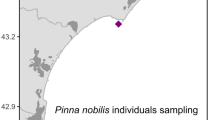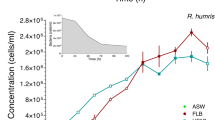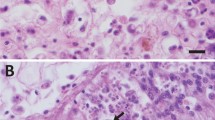Abstract
Haplosporidians are rhizarian parasites of mostly marine invertebrates. They include the causative agents of diseases of commercially important molluscs, including MSX disease in oysters. Despite their importance for food security, their diversity and distributions are poorly known. We used a combination of group-specific PCR primers to probe environmental DNA samples from planktonic and benthic environments in Europe, South Africa and Panama. This revealed several highly distinct novel clades, novel lineages within known clades and seasonal (spring vs autumn) and habitat-related (brackish vs littoral) variation in assemblage composition. High frequencies of haplosporidian lineages in the water column provide the first evidence for life cycles involving planktonic hosts, host-free stages or both. The general absence of haplosporidian lineages from all large online sequence data sets emphasises the importance of lineage-specific approaches for studying these highly divergent and diverse lineages. Combined with host-based field surveys, environmental sampling for pathogens will enhance future detection of known and novel pathogens and the assessment of disease risk.
Similar content being viewed by others
Log in or create a free account to read this content
Gain free access to this article, as well as selected content from this journal and more on nature.com
or
References
Altekar G, Dwarkadas S, Huelsenbeck JP, Ronquist F . (2004). Parallel metropolis coupled Markov chain Monte Carlo for Bayesian phylogenetic inference. Bioinformatics 20: 407–415.
Arzul I, Langlade A, Chollet B, Robert M, Ferrand S, Omnes E et al (2011). Can the protozoan parasite Bonamia ostreae infect larvae of flat oysters Ostrea edulis? Vet Parasitol 179: 69–76.
Bass D, Cavalier-Smith T . (2004). Phylum-specific environmental DNA analysis reveals remarkably high global biodiversity of Cercozoa (Protozoa). Int J Syst Evol Microbiol 54: 2393–2404.
Bass D, Chao EEY, Nikolaev S, Yabuki A, Ishida K-i, Berney C et al (2009). Phylogeny of novel naked filose and reticulose Cercozoa: Granofilosea cl. n. and Proteomyxidea revised. Protist 160: 75–109.
Bass D, Yabuki A, Santini S, Romac S, Berney C . (2012). Reticulamoeba is a long-branched Granofilosean (Cercozoa) that is missing from sequence databases. PLoS One 7: e49090.
Bearham D, Spiers Z, Raidal S, Jones JB, Nicholls PK . (2008). Detection of Minchinia sp., in rock oysters Saccostrea cuccullata (Born, 1778) using DNA probes. J Invertebr Pathol 97: 50–60.
Bearham D, Spiers ZB, Raidal SR, Jones JB, Nicholls PK . (2009). Detection of Minchinia occulta in samples of pearl oysters Pinctada maxima infected by Haplosporidium hinei. Aust Vet J 87: 430–437.
Berney C, Fahrni J, Pawlowski J . (2004). How many novel eukaryotic 'kingdoms'? Pitfalls and limitations of environmental DNA surveys. BMC Biol 2: 13.
Bik HM, Porazinska DL, Creer S, Caporaso JG, Knight R, Thomas WK . (2012). Sequencing our way towards understanding global eukaryotic biodiversity. TREE 27: 233–243.
Blaxter M, Mann J, Chapman T, Thomas F, Whitton C, Floyd R et al (2005). Defining operational taxonomic units using DNA barcode data. Phi Trans R Soc B 360: 1935–1943.
Bråte J, Logares R, Berney C, Ree DK, Klaveness D, Jakobsen KS et al (2010). Freshwater Perkinsea and marine-freshwater colonizations revealed by pyrosequencing and phylogeny of environmental rDNA. ISME J 4: 1144–1153.
Burreson EM, Ford SE . (2004). A review of recent information on the Haplosporidia, with special reference to Haplosporidium nelsoni (MSX disease). Aquat Living Resour 17: 499–517.
Canning EU, Okamura B . (2004). Biodiversity and evolution of the Myxozoa. Adv Parasitol 56: 43–131.
Carnegie RB, Burreson EM, Mike Hine P, Stokes NA, Audemard C, Bishop MJ et al (2006). Bonamia perspora n. sp.(Haplosporidia), a parasite of the oyster Ostreola equestris, is the first Bonamia species known to produce spores. J Eukaryot Microbiol 53: 232–245.
Carnegie RB, Cochennec-Laureau N . (2004). Microcell parasites of oysters: Recent insights and future trends. Aquat Living Resour 17: 519.
Cavalier-Smith T, Chao EEY . (2003). Phylogeny of Choanozoa, Apusozoa, and other Protozoa and early eukaryote megaevolution. J Mol Evol 56: 540–563.
Colwell RK, Mao CX, Chang J . (2004). Interpolating, extrapolating, and comparing incidence-based species accumulation curves. Ecology 85: 2717–2727.
Dong LF, Smith CJ, Papaspyrou S, Stott A, Osborn AM, Nedwell DB . (2009). Changes in benthic denitrification, nitrate ammonification, and anammox process rates and nitrate and nitrite reductase gene abundances along an estuarine nutrient gradient (the Colne Estuary, United Kingdom). Appl Environ Microbiol 75: 3171–3179.
Elston RA, Kent ML, Wilkinson MT . (1987). Resistance of Ostrea edulis to Bonamia ostreae infection. Aquaculture 64: 237–242.
Flores BS, Siddall ME, Burreson EM . (1996). Phylogeny of the Haplosporidia (Eukaryota: Alveolata) based on small subunit ribosomal RNA gene sequence. J Parasit 82: 616–623.
Hall TA . (1999). BioEdit: a user-friendly biological sequence alignment editor and analysis program for Windows 95/98/NT. Nucleic Acids Symp Ser 41: 95–98.
Hawkins RJ, Purdy KJ . (2007). Genotypic distribution of an indigenous model microorganism along an estuarine gradient. FEMS 62: 187–194.
Howe AT, Bass D, Chao EE, Cavalier-Smith T . (2011). New genera, species, and improved phylogeny of Glissomonadida (Cercozoa). Protist 162: 710–722.
Jones MDM, Forn I, Gadelha C, Egan MJ, Bass D, Massana R et al (2011). Discovery of novel intermediate forms redefines the fungal tree of life. Nature 474: 200–203.
Katoh K, Kuma K-i, Toh H, Miyata T . (2005). MAFFT version 5: improvement in accuracy of multiple sequence alignment. Nucleic Acids Res 33: 511–518.
Linton EW . (2005), MacGDE: genetic data environment for MacOS X. Software available at http://www.msu.edu/~lintone/macgde.
Logares R, Audic S, Santini S, Pernice MC, de Vargas C, Massana R . (2012). Diversity patterns and activity of uncultured marine heterotrophic flagellates unveiled with pyrosequencing. ISME J 6: 1823–1833.
Longshaw M, Malham SK . (2012). A review of the infectious agents, parasites, pathogens and commensals of European cockles (Cerastoderma edule and C. glaucum). J Mar Biol Assoc UK 1: 1–21.
López-Garcıa P, Vereshchaka A, Moreira D . (2006). Eukaryotic diversity associated with carbonates and fluid-seawater interface in Lost City hydrothermal field. Environ Microbiol 9: 546–554.
Miller MA, Pfeiffer W, Schwartz T . (2010). Gateway Computing Environments Workshop (GCE), 2010. IEEE pp 1–8.
Molloy DP, GiambÉRini L, Stokes NA, Burreson EM, Ovcharenko MA . (2012). Haplosporidium raabei n. sp.(Haplosporidia): a parasite of zebra mussels, Dreissena polymorpha (Pallas, 1771). Parasitology 139: 463–477.
Moreira D, López-Garcıa P . (2002). The molecular ecology of microbial eukaryotes unveils a hidden world. Trends Microb 10: 31–38.
Nardsi V, Arzul I, Cargini D, Mosca F, Calzetta A, Traversa D et al (2011). Detection of Bonamia ostreae and B. exitiosa (Haplosporidia) in Ostrea edulis from the Adriatic Sea (Italy). Dis Aquat Org 89: 79–85.
Newman MW, Johnson CA, Pauley GB . (1976). A Minchinia-like haplosporidan parasitizing blue crabs, Callinectes sapidus. J Invertebr Pathol 27: 311–315.
Okamura B, Feist S . (2011). Emerging diseases in freshwater systems. Freshwater Biol 56: 627–637.
Pawlowski J, Audic S, Adl S, Bass D, Belbahri L, Berney C et al (2013). CBOL protist working group: barcoding eukaryotic richness beyond the animal, plant, and fungal kingdoms. PLoS Biol 10: e1001419.
Perkins FO . (2000). An Illustrated Guide to the Protozoa. Vol. 1 Lee JJ, Leedale GF, Bradbury P (eds). Society of Protozoologists: Lawrence, Kansas, USA, pp 1328–1341.
Pichot Y, Comps M, Tige G, Grizel H, Rabouin MA . (1980). Recherches sur Bonamia ostreae gen. n. sp. n. parasite nouveau de l'huître plate Ostrea edulis L. Revue des Travaux de l'Institut des Pêches Maritimes 43: 131–140.
Reece KS, Siddall ME, Stokes NA, Burreson EM . (2004). Molecular phylogeny of the Haplosporidia based on two independent gene sequences. J Parasitol 90: 1111–1122.
Richards TA, Bass D . (2005). Molecular screening of free-living microbial eukaryotes: diversity and distribution using a meta-analysis. Curr Opin Microbiol 8: 240–252.
Ronquist F, Huelsenbeck JP . (2003). MrBayes 3: Bayesian phylogenetic inference under mixed models. Bioinformatics 19: 1572–1574.
Seaby RMH, Henderson PA . (2007) Community Analysis Package 4.0. PISCES Conservation Ltd: Lymington, UK, p 154.
Seshadri R, Kravitz SA, Smarr L, Gilna P, Frazier M . (2007). CAMERA: a community resource for metagenomics. PLoS Biol 5: e75.
Siddall ME, Aguado MT . (2006). Molecular phylogenetic evidence of a haplosporidian parasite infecting the polychaete Syllis nipponica (Imajima, 1966). Parasitol Res 99: 309–312.
Skovgaard A, Daugbjerg N . (2008). Identity and systematic position of Paradinium poucheti and other paradinium-like parasites of marine copepods based on morphology and nuclear-encoded SSU rDNA. Protist 159: 401–413.
Stamatakis A . (2006). RAxML-VI-HPC: maximum likelihood-based phylogenetic analyses with thousands of taxa and mixed models. Bioinformatics 22: 2688–2690.
Stamatakis A, Hoover P, Rougemont J . (2008). A rapid bootstrap algorithm for the RAxML Web servers. Syst Biol 57: 758–771.
Stentiford GD, Bateman KS, Stokes NA, Carnegie RB . (2013). Haplosporidium littoralis sp. nov.: a crustacean pathogen within the Haplosporida (Cercozoa, Ascetosporea). Dis Aquat Org doi:10.3354/dao02619.
Stentiford GD, Feist SW, Bateman KS, Hine PM . (2004). Haemolymph parasite of the shore crab Carcinus maenas: pathology, ultrastructure and observations on crustacean haplosporidians. Dis Aquat Org 59: 57–68.
Stokes NA, Siddall ME, Burreson EM . (1995). Small subunit ribosomal RNA gene sequence of Minchinia teredinis (Haplosporidia: Haplosporidiidae) and a specific DNA probe and PCR primers for its detection. J Invertebr Pathol 65: 300–308.
Sun S, Chen J, Li W, Altintas I, Lin A, Peltier S et al (2011). Community cyberinfrastructure for advanced microbial ecology research and analysis: the CAMERA resource. Nucleic Acids Res 39: D546–D551.
Utari HB, Senapin S, Jaengsanong C, Flegel TW, Kruatrachue M . (2012). A haplosporidian parasite associated with high mortality and slow growth in Penaeus (Litopenaeus) vannamei cultured in Indonesia. Aquaculture 366-367: 85–89.
Wuyts J, De Rijk P, Van de Peer Y, Pison G, Rousseeuw P, De Wachter R . (2000). Comparative analysis of more than 3000 sequences reveals the existence of two pseudoknots in area V4 of eukaryotic small subunit ribosomal RNA. Nucleic Acids Res 28: 4698–4708.
Wuyts J, Van de Peer Y, Winkelmans T, De Wachter R . (2002). The European database on small subunit ribosomal RNA. Nucleic Acids Res 30: 183–185.
Acknowledgements
This research was supported by The NHM Special Funds Grant and Expedition Funds (South Africa) to BO and DB and NERC New Investigator (NE/H000887/1) and Standard Research (NE/H009426/1) Grants to DB. We thank Kristina Hamilton and Bryony Williams from the University of Exeter, Kevin Purdy and Mark Osborn from the University of Warwick and the BioMarKs consortium for access to samples. We acknowledge the Western Cape Nature Conservation Board for permission to sample in South Africa (Permit number 0035-AAA007-00375). GS and SF were supported by the Department for Environment, Food and Rural Affairs project no. C5485 (to GS).
Author information
Authors and Affiliations
Corresponding author
Ethics declarations
Competing interests
The authors declare no conflict of interest.
Additional information
Supplementary Information accompanies this paper on The ISME Journal website
Rights and permissions
About this article
Cite this article
Hartikainen, H., Ashford, O., Berney, C. et al. Lineage-specific molecular probing reveals novel diversity and ecological partitioning of haplosporidians. ISME J 8, 177–186 (2014). https://doi.org/10.1038/ismej.2013.136
Received:
Revised:
Accepted:
Published:
Issue date:
DOI: https://doi.org/10.1038/ismej.2013.136
Keywords
This article is cited by
-
The planktonic protist interactome: where do we stand after a century of research?
The ISME Journal (2020)



